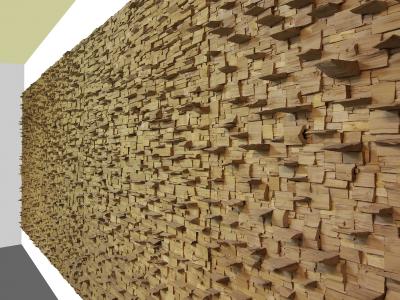Jan de Weryha-Wysoczański
Mediathek Sorted






































































































The De Stijl group and early constructivists were not yet interested in material phenomena. In Germany people only discussed and propagated the appropriate use of natural materials in industrial modernism in connection with the applied arts (i.e. arts and crafts), from the Deutscher Werkbund, founded in 1907. In Western Europe object art only developed in a slow process, moving from the invention of collage as an artistic technique by DADA artists around 1916, via the "MERZ pictures" by Kurt Schwitters, to his object and spatial collages, like the walk-through "Merzbau", created in 1923. That said, constructivist sculpture, in which the material played a new role, had evolved much earlier in Moscow. Beginning in 1914, Vladimir Tatlin still in close connection with Futurism and Suprematism, developed three-dimensional "corners" and "counter-reliefs" made of found materials like wood, iron, zinc, leather and metal wires, thereby propagating a "culture of the material".
Under the influence of the Russian Revolution, Alexander Rodchenko and El Lissitzky developed geometrically determined, constructivist objects that were intended to be "non-objective in a material world". Emigrants from Moscow like Naum Gabo and his brother Antoine Pevsner exported these ideas to Berlin and Paris, and Katarzyna Kobro exported them to Warsaw, where she emigrated in 1922. As the equivalent of the modern world they introduced into sculpture smooth, industrially manufactured and shaped materials like Plexiglas, sheet steel, industrially processed glass and wood in geometric forms and pure colours. Starting in 1919, the Staatliches Bauhaus in Weimar and Dessau not only offered a discussion and teaching platform for all previous and current branches of constructivism, but also propagated its application in all areas of life. To this day, its resonance has shaped broad areas of art theory and our everyday lives.
In Poland (after the first Constructivist works by Henryk Stażewski and the founding of the Blok group in 1924 by Stażewski, Henryk Berlewi and Władysław Strzemiński, who had been married to Kobro since 1920), an independent tradition of Constructivism emerged. Although it reflected the entire European movement, it was hardly noticed by the West. It was followed in the 1960s and 1970s by a "neo-avant-garde" connected to Constructivism. The artists included Edward Krasiński in object art, Zofia Artymowska and Jerzy Grabowski in graphic art, and Józef Robakowski and Ryszard Waśko in painting, film, video, and object art. Today, young Polish artists such as Natalia Stachon and Marlena Kudlicka, some of whom work in Germany, once again refer back to the first generation of the Constructivist Polish avant-garde.
De Weryha initially applied geometric forms to the arrangement of his floor works (ill. 14, 16, 26, 29), then to free-standing objects like the "Wooden Pillar" (ill. 38), the "Wooden Cube" (ill. 40) and the cone-shaped "Wooden Object" (ill. 93), and finally to the internal structure of his "Wooden Panels" (ill. 78, 91, 92). But these rigorous, regular works also point back to Concrete Art, which followed Constructivism. Introduced by van Doesburg and followed up by the 'Art concret' group founded in Paris in 1929, this movement with the Swiss Max Bill and Richard Paul Lohse was given its theoretical basis in 1936 and the 1940s, a basis that is still valid today. While Bill initially only allowed strict mathematical and geometric systems as the basis for "subjective forms" in art, in the 1960s he also allowed statistically calculated, uniform distributions, regular grids and "orders". Starting in 1940, Lohse researched "serial" and "modular orders", which he propagated in the 1980s.[1]
[1] Richard Paul Lohse: Modulare Ordnungen (1985), Serielle Ordnungen (1985), in: Richard Paul Lohse 1902-1988, exhibition catalog Wilhelm-Hack-Museum, Ludwigshafen 1992, p. 18 f., 21 f.





















































































